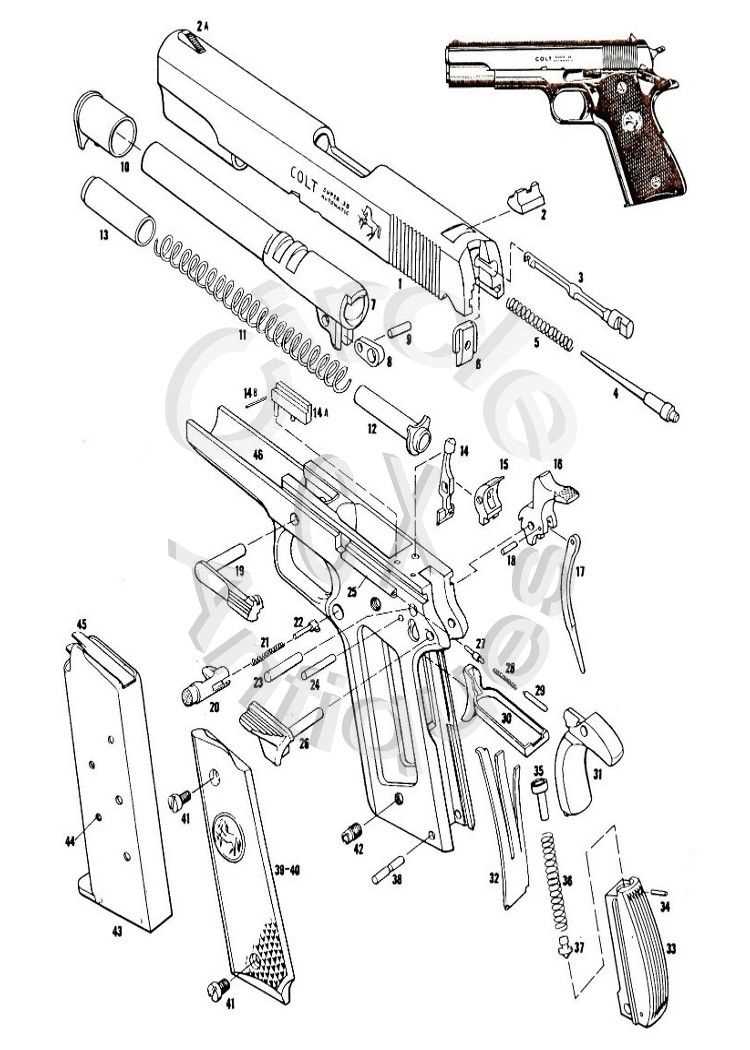
The 1911 pistol is a legendary firearm that has been in use for over a century. It is known for its reliability, durability, and accuracy, making it a favorite among gun enthusiasts, law enforcement officers, and military personnel. To understand the inner workings of this iconic handgun, it is essential to familiarize yourself with its parts and their functions.
The 1911 pistol parts diagram provides a visual representation of the various components that make up this firearm. From the muzzle to the grip, every part has a specific role in the function and operation of the weapon. Some of the key components include the slide, barrel, frame, and trigger. The slide houses the firing pin and extractor, while the barrel is responsible for guiding the bullet’s trajectory. The frame contains the magazine well and houses the trigger mechanism, ensuring that the pistol fires when the trigger is pulled.
Understanding the different parts of the 1911 pistol is crucial for maintenance and troubleshooting. By knowing how each component interacts with others, gun owners can identify and address any issues that may arise such as misfires or jams. Additionally, being knowledgeable about the parts can also help enthusiasts personalize their firearms by upgrading specific components like the trigger or sights. Whether you are a seasoned shooter or just starting your journey with firearms, a 1911 pistol parts diagram is an invaluable resource for anyone interested in this iconic handgun.
Understanding the 1911 Pistol: A Complete Guide to its Parts
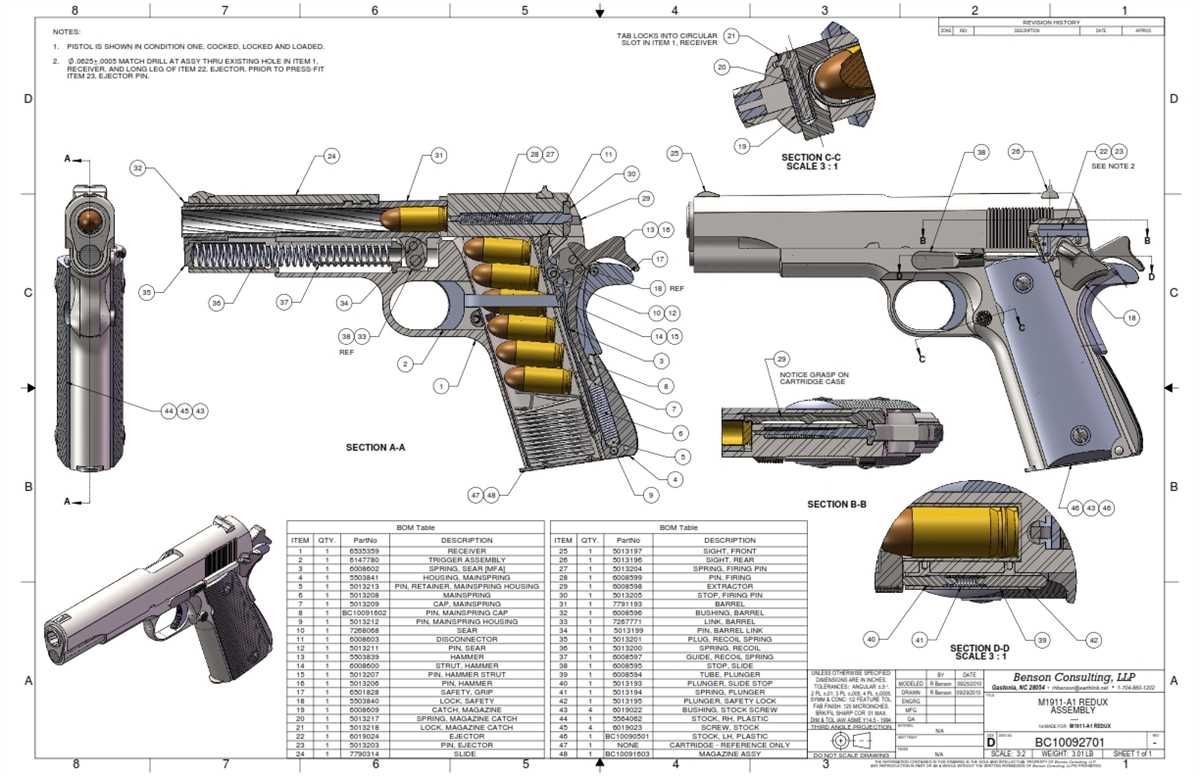
The 1911 pistol, also known as the Colt 1911 or Government Model, is a semi-automatic handgun that was first produced over a century ago. It has become an iconic firearm, respected for its reliability, accuracy, and timeless design. To truly understand this legendary pistol, it is essential to have a comprehensive knowledge of its various parts and their functions.
1. Frame: The frame is the foundation of the 1911 pistol. It is typically made of steel and houses all the other components. The grip panels attach to the frame, providing a comfortable and secure hold on the pistol.
2. Slide: The slide is a moving component that sits on top of the frame. It houses the barrel, recoil spring, and firing pin. When the pistol is fired, the slide moves backward, extracting and ejecting the spent casing, and then moves forward, loading a new round from the magazine.
3. Barrel: The barrel is where the projectile travels through when the pistol is fired. It is typically made of steel and has rifling, which imparts spin on the projectile for improved accuracy. The barrel is threaded into the frame and locked in place during firing by the barrel bushing and recoil spring plug.
4. Recoil Spring: The recoil spring is a vital part of the 1911 pistol’s mechanism. It absorbs the recoil energy generated when the pistol is fired, effectively reducing muzzle flip and aiding in the cycle of operation.
5. Trigger: The trigger is the part of the pistol that is directly manipulated by the shooter to initiate the firing sequence. Pulling the trigger releases the sear, allowing the hammer to strike the firing pin and ignite the primer of the cartridge.
6. Magazine: The magazine is a detachable box that holds the ammunition and feeds it into the pistol’s chamber. The standard capacity of a 1911 pistol magazine is typically seven or eight rounds, although higher-capacity magazines are also available.
7. Safety: The safety is a crucial component of the 1911 pistol that ensures it can be carried safely. The 1911 has both a manual thumb safety and a grip safety, which must be disengaged to fire the pistol.
8. Sights: The sights are located on the slide and provide a means for aiming the pistol. Most 1911 pistols feature a front post sight and a rear notch sight, although various aftermarket sights are available to suit individual preferences.
9. Hammer: The hammer is responsible for striking the firing pin and initiating the firing sequence. It can be cocked manually or automatically when the slide moves to its fully rearward position.
10. Slide Stop: The slide stop is a small lever located on the left side of the frame near the trigger guard. It holds the slide in its rearward position when the last round in the magazine is fired, indicating that the pistol is empty.
Understanding the various parts of the 1911 pistol is essential for any shooter or enthusiast. With this knowledge, one can appreciate the design and functionality of this iconic firearm that has stood the test of time.
Overview of the 1911 Pistol
The 1911 pistol is a legendary firearm that has been in use for over a century. Designed by John Browning in the early 20th century, it has become one of the most iconic handguns in history. The 1911 pistol has been widely adopted by military and law enforcement agencies, as well as civilian shooters, due to its reliability, accuracy, and stopping power.
The 1911 pistol is a semi-automatic handgun that uses a single-stack magazine and is chambered in .45 ACP. It features a single-action trigger, which means that the hammer must be manually cocked before the first shot is fired. This gives the shooter a lighter and more consistent trigger pull, resulting in improved accuracy.
The 1911 pistol is known for its solid construction and ergonomics. The frame and slide are typically made from steel, providing durability and a solid feel in the hand. The grip angle and grip texture of the 1911 pistol have been praised by many shooters, making it comfortable to hold and shoot for extended periods of time.
The 1911 pistol has a number of distinctive features that set it apart from other handguns. One of the most recognizable features is the grip safety, which must be fully depressed in order for the trigger to be pulled. This added safety feature helps prevent accidental discharges and has become an integral part of the 1911 design.
Another notable feature of the 1911 pistol is the thumb safety, which allows the shooter to engage or disengage the safety with a single thumb movement. This enables the shooter to quickly and easily manipulate the safety, making the 1911 pistol a popular choice for those in law enforcement and military roles.
In conclusion, the 1911 pistol is a timeless firearm that has stood the test of time. Its reliability, accuracy, and stopping power have made it a favorite among shooters all over the world. Whether used for self-defense, competition shooting, or simply as a collector’s item, the 1911 pistol continues to be a symbol of American craftsmanship and ingenuity.
Key Components of the 1911 Pistol
The 1911 pistol is a classic firearm that has remained popular for over a century. It was designed by John M. Browning and has been widely adopted by military and law enforcement organizations around the world. The pistol is known for its reliability, accuracy, and iconic design. To understand how the 1911 pistol operates, it is important to be familiar with its key components.
1. Frame
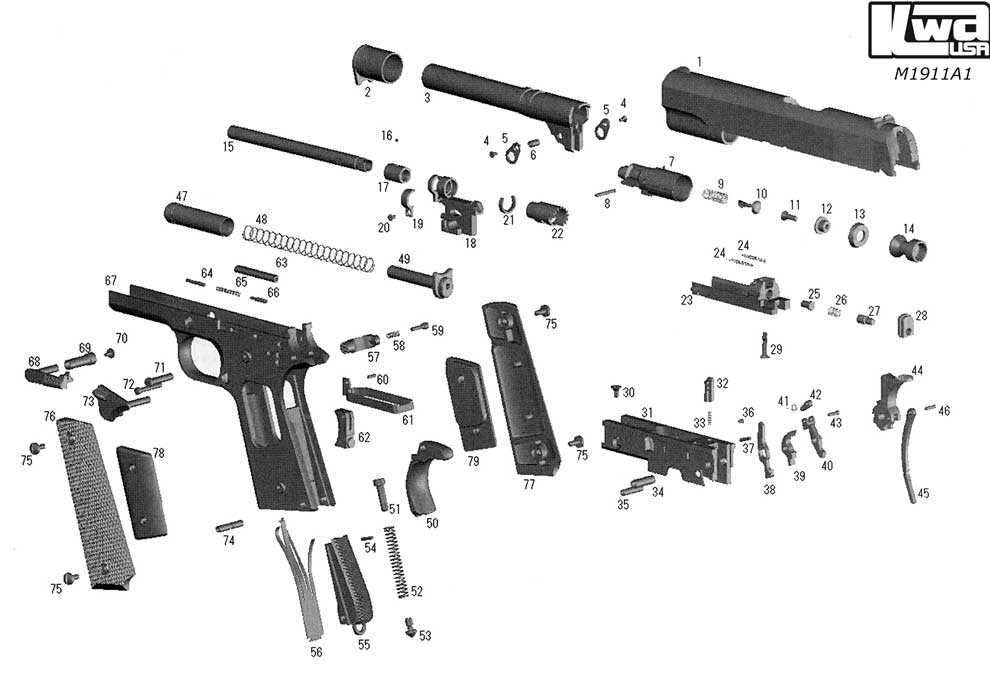
The frame is the main part of the pistol and houses the other components. It is typically made of metal, such as steel or aluminum alloy, and provides the structure and strength necessary for the pistol to function properly. The frame also includes the grip, which allows the shooter to hold and control the pistol.
2. Slide
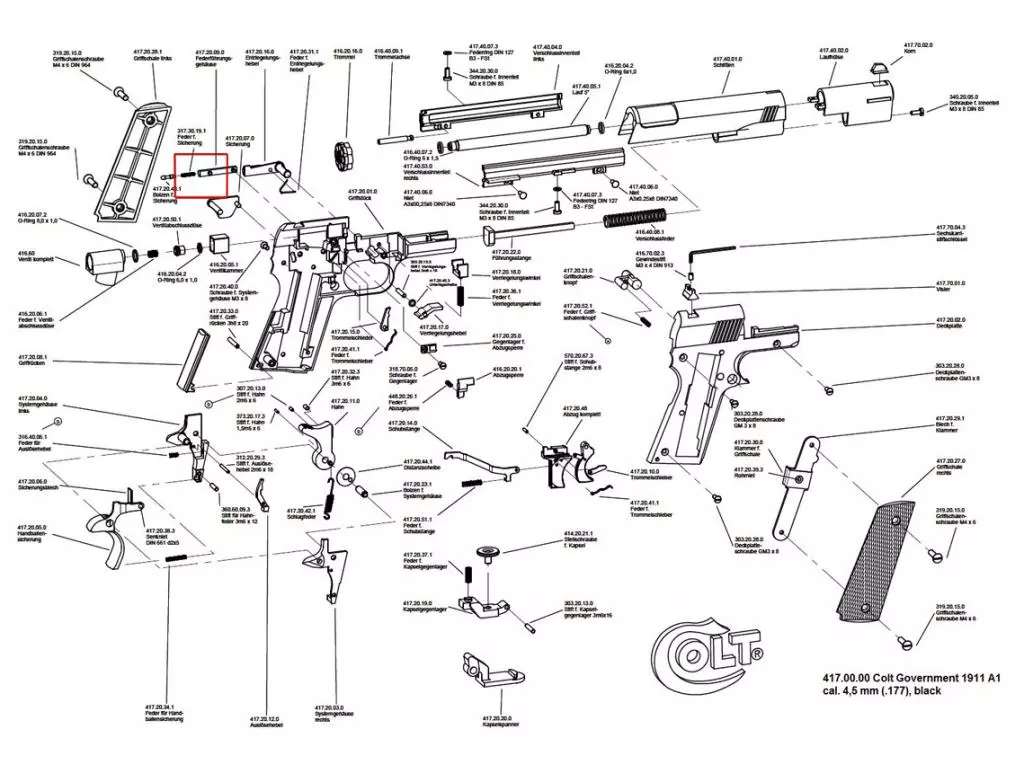
The slide is the upper portion of the pistol that moves backward and forward to load and unload cartridges from the magazine. It is typically made of steel and contains the firing pin, extractor, and ejector. The slide is an essential component for the functioning of the pistol and is responsible for cycling the action.
3. Barrel
The barrel is located within the frame and acts as a guide for the projectile as it travels down the barrel. It is responsible for directing and stabilizing the bullet, as well as providing a path for the expanding gases to escape. The barrel is typically made of steel and may have rifling, which consists of helical grooves that impart spin to the bullet for improved accuracy.
4. Sights
Sights are used to aim the pistol and ensure accuracy. The 1911 pistol typically features a front sight and a rear sight. The front sight is located on the slide, while the rear sight is located on the frame. The sights may be adjustable or fixed, depending on the model.
5. Trigger
The trigger is the part of the pistol that is pulled to fire a shot. It is located within the trigger guard and is connected to the sear, which holds the hammer back until the trigger is pulled. The trigger pull weight and length of travel can vary depending on the specific model and user preferences.
These are just a few of the key components of the 1911 pistol. Each component plays a crucial role in the overall function and performance of the firearm. Understanding these components is essential for anyone looking to learn more about this iconic pistol or operate it safely and effectively.
Frame and Slide Assembly
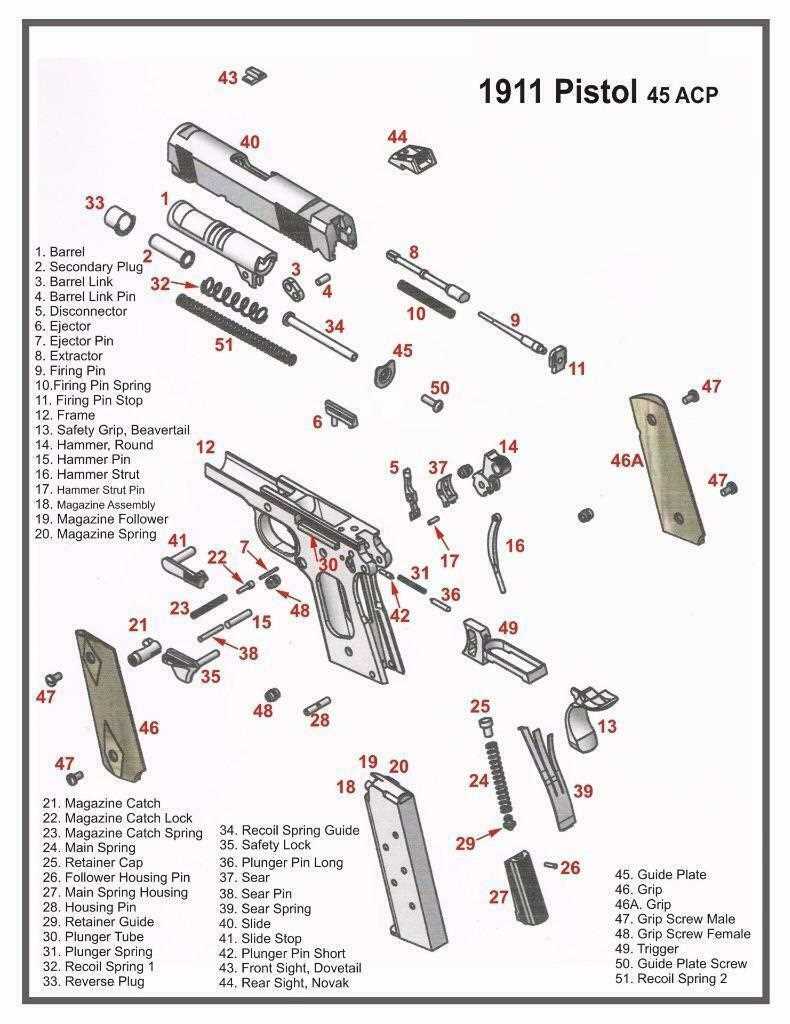
The frame and slide assembly is a crucial part of a 1911 pistol. It is responsible for housing and organizing the various parts of the pistol and allowing them to function together. The frame is typically made of steel and serves as the foundation for the entire pistol. It includes the grip and trigger guard, providing a comfortable and secure hold for the shooter.
The slide, on the other hand, is usually made of steel or an alloy and houses the barrel and recoil spring assembly. It moves backward during the firing cycle, extracting and ejecting the spent casing, and then moves forward again, chambering a new round from the magazine. This reciprocating motion is facilitated by the interaction of various components within the frame and slide assembly, such as the slide stop, recoil spring, and slide rails.
Key components of the frame and slide assembly include the trigger, hammer, sear, and disconnector. These parts work in harmony to control the firing sequence of the pistol. When the trigger is pulled, it releases the hammer to strike the firing pin, igniting the cartridge primer and propelling the bullet out of the barrel. The sear and disconnector ensure that the trigger resets and the hammer remains cocked after each shot, allowing for rapid and accurate follow-up shots.
Overall, the frame and slide assembly is the backbone of the 1911 pistol, providing a sturdy and reliable platform for its operation. Each component within this assembly plays a vital role in the pistol’s functionality and must be carefully designed and manufactured to ensure proper performance. Whether for self-defense, competition shooting, or recreational use, the frame and slide assembly is essential for any 1911 enthusiast.
Barrel and Recoil System
The barrel and recoil system are crucial components of a 1911 pistol, playing a key role in ensuring its accuracy, reliability, and overall performance. Let’s take a closer look at these components and their functions.
Barrel
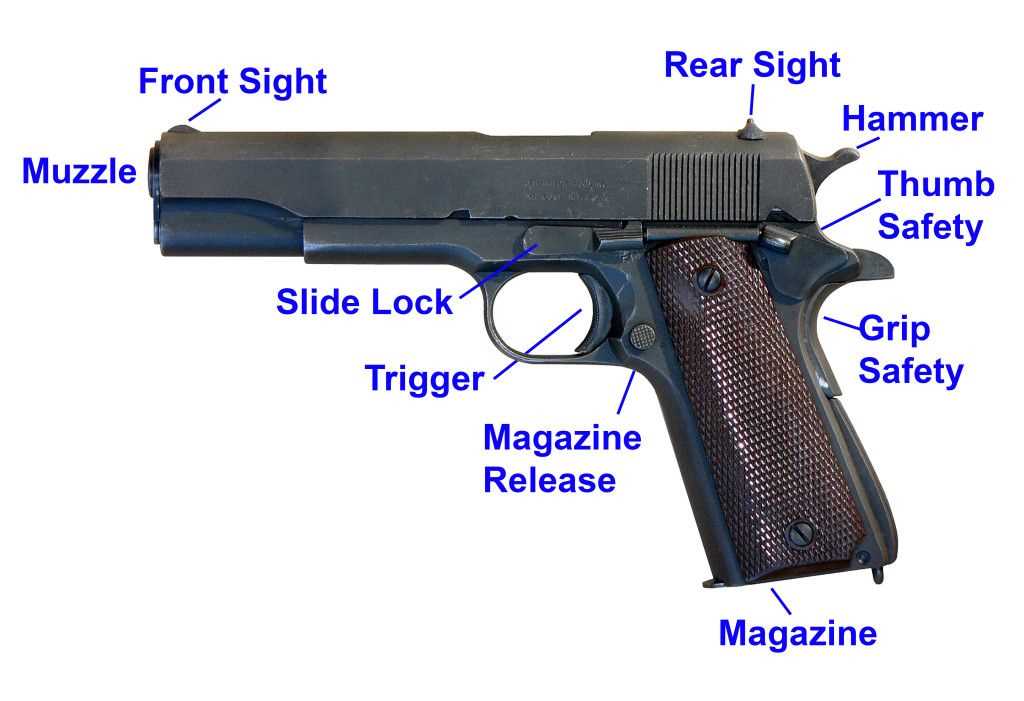
The barrel is the cylindrical tube through which the bullet travels when fired. It is typically made of high-quality steel to withstand the immense pressure generated by the combustion of the propellant. The barrel is rifled, with spiral grooves cut into the inner surface to impart a spin to the bullet, thus stabilizing its flight and improving accuracy.
The barrel of a 1911 pistol is threaded at the muzzle end, allowing for the attachment of various accessories such as compensators or suppressors. Some barrels also feature a bushing at the front that allows for easier disassembly and field-stripping of the pistol.
Recoil System
The recoil system is responsible for managing the recoil forces generated when a round is fired. It consists of several components, including the recoil spring, guide rod, and plug.
The recoil spring is a vital part of the system, as it absorbs and controls the energy generated by the expanding gases. It helps to push the slide and barrel assembly rearward during the firing cycle and then returns them to their forward position, ready for the next shot. The strength of the recoil spring can be adjusted to accommodate different ammunition loads and maintain proper cycling of the pistol.
- The recoil spring is typically housed within a guide rod, which serves as a guide for the spring and helps keep it aligned.
- The guide rod is inserted through the front of the slide and extends into the recoil spring plug, which fits into the front end of the slide.
- Some 1911 pistols feature a dual recoil spring system, which helps to reduce felt recoil and improve overall shooting comfort.
In summary, the barrel and recoil system are critical components of a 1911 pistol, contributing to its accuracy, reliability, and overall shooting performance. The barrel provides a stable path for the bullet and imparts spin for improved accuracy, while the recoil system manages the forces generated during firing and ensures proper cycling of the pistol. Understanding these components is essential for maintaining and optimizing the performance of a 1911 pistol.
Trigger Mechanism and Safety Features
The trigger mechanism of a 1911 pistol is a critical component responsible for initiating the firing sequence. It consists of several parts working together to ensure safe and reliable operation. The key components include the trigger, sear, hammer, and disconnector.
When the trigger is pulled, it engages the sear, which holds the hammer in a cocked position. As the trigger continues to move rearward, the sear releases the hammer, allowing it to strike the firing pin and ignite the cartridge. The trigger pull weight can be adjusted to suit the shooter’s preference.
Several safety features are integrated into the trigger mechanism to prevent accidental discharges and enhance user safety. The most prominent safety feature is the grip safety, located at the rear of the grip. It must be fully depressed to allow the trigger to be pulled. This safety feature ensures that the pistol cannot be fired unless it is securely held in the shooter’s hand.
In addition to the grip safety, the 1911 pistol also has a thumb safety located on the left side of the frame. The thumb safety can be engaged or disengaged to prevent the trigger from being pulled. When engaged, it locks the trigger and slide, rendering the pistol “safe” and preventing it from firing.
Overall, the trigger mechanism and safety features of the 1911 pistol work together to provide a reliable and safe shooting experience. They allow the shooter to have control over when the pistol fires and prevent accidental discharges, ensuring the utmost safety while handling the firearm.
Additional Parts and Accessories for the 1911 Pistol

The 1911 pistol has been widely used and loved by shooters for over a century. It has become a symbol of reliability, accuracy, and craftsmanship. While the pistol itself is a remarkable piece of engineering, there are also a variety of additional parts and accessories available to enhance its performance and functionality.
1. Extended Magazine Release
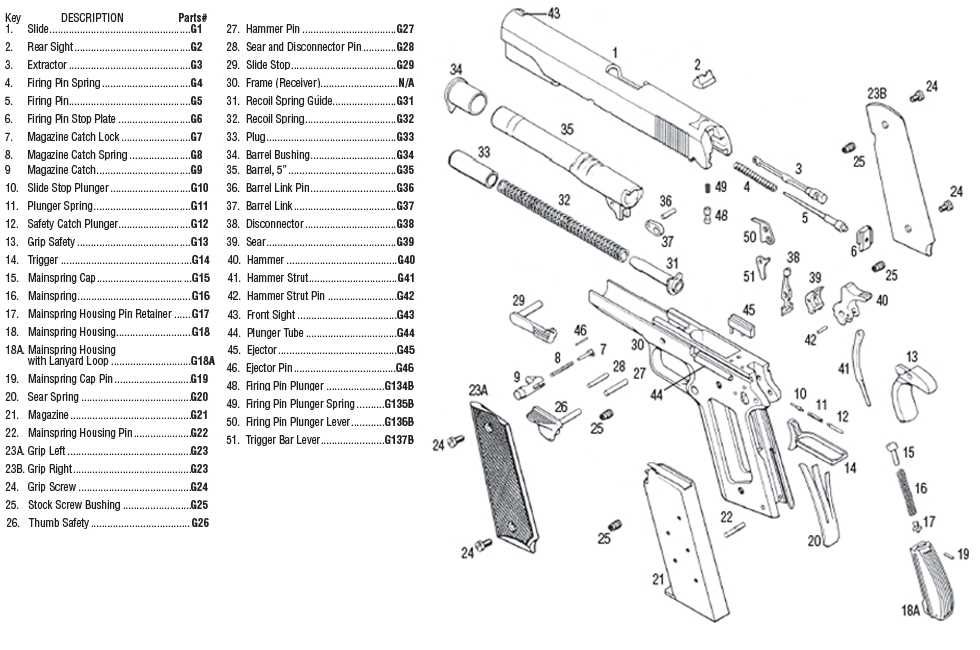
A common upgrade for the 1911 pistol is an extended magazine release. This accessory allows for quicker and easier magazine changes, especially for shooters with smaller hands. By extending the release button, it becomes more accessible and can be activated without shifting your grip on the pistol.
2. Ambidextrous Safety
The 1911 pistol typically features a thumb safety on the left side of the frame, which is intended for right-handed shooters. However, there are ambidextrous safety options available for left-handed or ambi-dextrous shooters. These safeties allow for easy manipulation of the safety from either side, enhancing the pistol’s usability for a wider range of shooters.
3. Extended Slide Stop
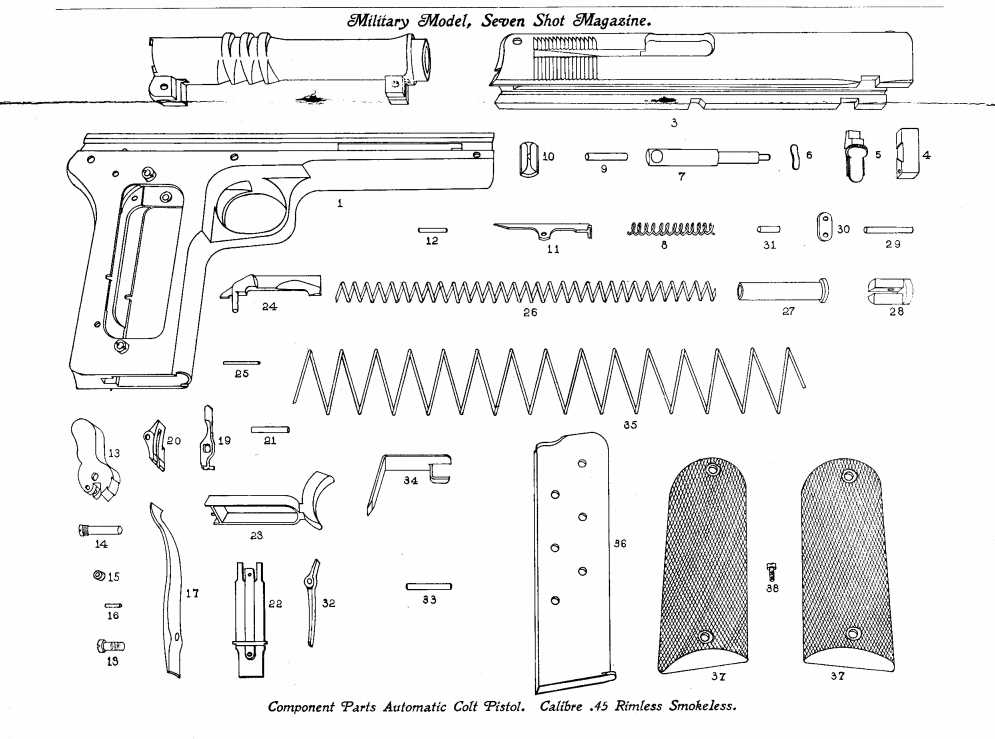
An extended slide stop is another popular upgrade for the 1911 pistol. This accessory extends the length of the slide stop lever, making it easier to engage and disengage the slide. It provides a larger surface area for your thumb, enabling more reliable and faster slide manipulation during reloads or malfunction drills.
4. Fiber Optic Sights
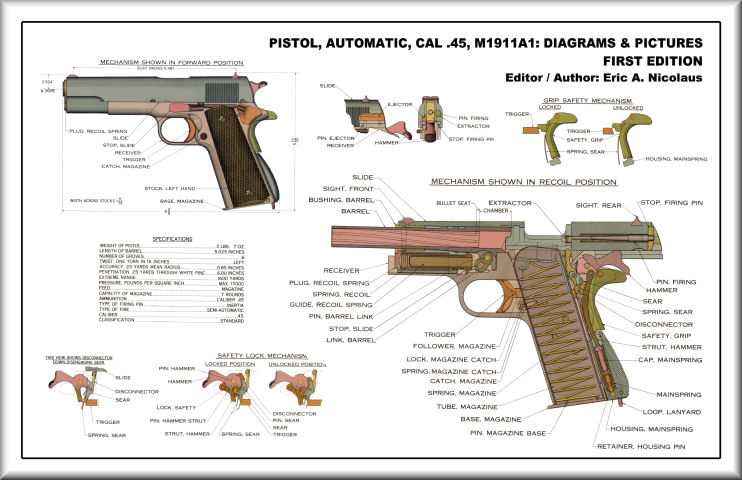
Fiber optic sights are a modern replacement for traditional iron sights on the 1911 pistol. These sights utilize fiber optic rods that gather and transmit ambient light to create a bright aiming point. The enhanced visibility of the front sight improves target acquisition and sight picture, especially in low-light conditions or fast-paced shooting scenarios.
5. Match Grade Barrel
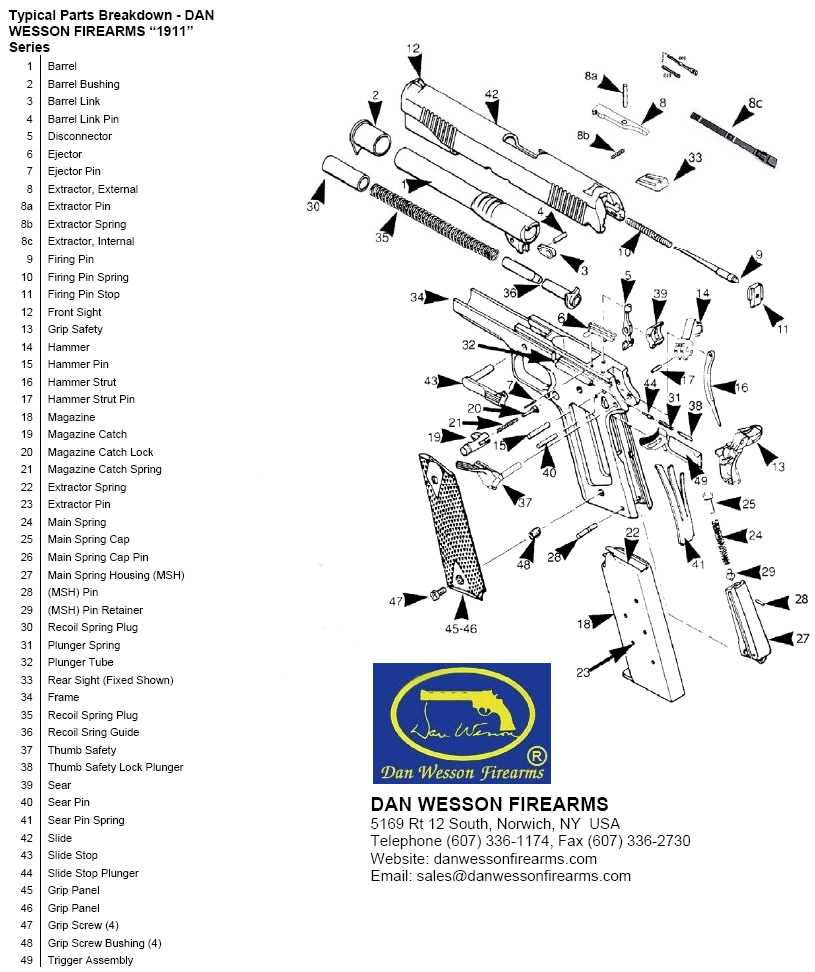
A match grade barrel is designed to provide superior accuracy and consistency to the 1911 pistol. These barrels are precision-machined and fitted to tighter tolerances compared to standard barrels. They can improve the pistol’s inherent accuracy potential, making it more suitable for competitive shooting or precision shooting applications.
6. Grips and Grip Panels
Grips and grip panels are available in a wide variety of materials, textures, and designs for the 1911 pistol. These accessories allow shooters to personalize their pistol’s aesthetics and improve their grip and control. Options range from traditional wood grips to textured polymer grips and even custom-made grips with unique patterns or logos.
Overall, the 1911 pistol offers a wide range of additional parts and accessories to enhance its performance, usability, and aesthetics. Whether you are a competitive shooter, a concealed carry holder, or simply an enthusiast, these upgrades can further optimize your 1911 pistol to suit your specific needs and preferences.